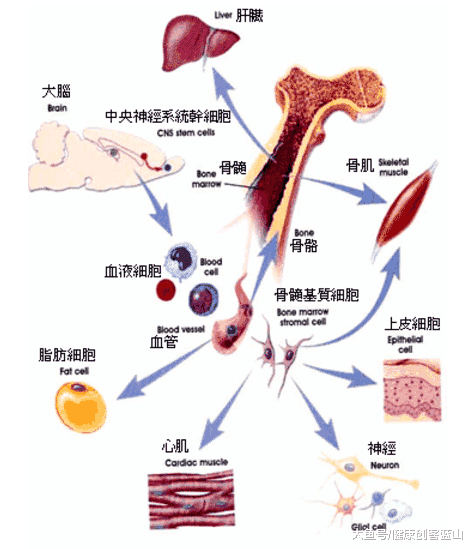McMaster 大学发现运动促使骨髓干细胞成为骨骼 而久坐则导致脂肪细胞填满骨髓
Exercise boosts health by influencing stem cells to become bone, not fat, researchers find
导读:虽然最近研究表明,肺也是重要的造血器官,但是人体的大部分血液源自骨髓的造血干细胞。这个研究发现将进一步激励像我一样的运动爱好者。在一个研究中,科学家发现,注射骨髓干细胞可以改善心肌梗塞后患者心脏功能的康复。
虽然最近研究表明,肺也是重要的造血器官,但是人体的大部分血液源自骨髓的造血干细胞
、
麦克马斯特大学的研究人员还发现了锻炼的另一个原因:锻炼能够激发有影响力的干细胞,使其变成骨骼而不是脂肪,通过提高身体的造血能力来改善整体健康状况。
人体的间充质干细胞最有可能变成脂肪或骨骼,这取决于它们的路径。
运动机能学部门的詹尼·帕丽斯(Gianni Parise)领导的一个研究小组用跑步机训练过的老鼠证明,有氧运动更容易使这些细胞变成骨骼而不是脂肪。
Parise副教授说,运动的老鼠每周跑三次,每次不到一小时,足够对它们的血液产生重大影响。
在久坐不动的小鼠中,同样的干细胞更有可能变成脂肪,损害骨髓腔内的血液生产。
Parise副教授说,运动的老鼠每周跑三次,每次不到一小时,足够对它们的血液产生重大影响
这项研究发表在《美国实验生物学学会联合会杂志》上的一篇新论文中。
“有趣的是,适度的锻炼能够显著增加骨髓和血液循环中的血细胞,”Parise说。“我们的建议是,运动是一种强有力的刺激——足以刺激这些间充质干细胞的开关。”
骨髓腔内细胞的组成对造血干细胞的产量有重要影响。
在理想的条件下,血液干细胞产生健康的血液,增强免疫系统,允许有效的吸氧,提高伤口的凝血能力。
骨细胞改善了造血干细胞的环境。
但当脂肪细胞开始填满骨髓腔——这是久坐不动的常见症状——造血干细胞的产量就会降低,贫血等症状也会出现。
Parise说,这一发现增加了锻炼的好处,并提示未来可能会出现治疗血液相关疾病的非药物疗法。
他说:“运动的一些影响可以与我们看到的药物干预相媲美。”运动有影响干细胞生物学的能力。它有能力影响他们如何分化。
Exercise boosts health by influencing stem cells to become bone, not fat, researchers find
Date:
September 9, 2011
Source:
McMaster University
Summary:
Researchers have found one more reason to exercise: working out triggers influential stem cells to become bone instead of fat, improving overall health by boosting the body's capacity to make blood.
Share:
FULL STORY
McMaster researchers have found one more reason to exercise: working out triggers influential stem cells to become bone instead of fat, improving overall health by boosting the body's capacity to make blood.
The body's mesenchymal stem cells are most likely to become fat or bone, depending on which path they follow.
Using treadmill-conditioned mice, a team led by the Department of Kinesiology's Gianni Parise has shown that aerobic exercise triggers those cells to become bone more often than fat.
The exercising mice ran less than an hour, three times a week, enough time to have a significant impact on their blood production, says Parise, an associate professor.
In sedentary mice, the same stem cells were more likely to become fat, impairing blood production in the marrow cavities of bones.
The research appears in a new paper published by the Journal of the Federation of American Societies for Experimental Biology.
"The interesting thing was that a modest exercise program was able to significantly increase blood cells in the marrow and in circulation," says Parise. "What we're suggesting is that exercise is a potent stimulus -- enough of a stimulus to actually trigger a switch in these mesenchymal stem cells."
The composition of cells in the bone marrow cavity has an important influence on the productivity of blood stem cells.
In ideal conditions, blood stem cells create healthy blood that boosts the immune system, permits the efficient uptake of oxygen, and improves the ability to clot wounds.
Bone cells improve the climate for blood stem cells to make blood.
But when fat cells start to fill the bone marrow cavity -- a common symptom of sedentary behavior -- blood stem cells become less productive, and conditions such as anemia can result.
The findings add to the growing list of established benefits of exercise, Parise says, and suggest that novel non-medicinal treatments for blood-related disorders may be in the future.
"Some of the impact of exercise is comparable to what we see with pharmaceutical intervention," he says. "Exercise has the ability to impact stem cell biology. It has the ability to influence how they differentiate."
Story Source:
Materials provided by McMaster University. Note: Content may be edited for style and length.
Journal Reference:
J. M. Baker, M. De Lisio, G. Parise. Endurance exercise training promotes medullary hematopoiesis. The FASEB Journal, 2011; DOI: 10.1096/fj.11-189043
https://www.sciencedaily.com/releases/2011/09/110901112531.htm

.png)